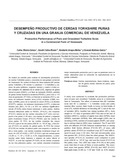Mostrar el registro sencillo del ítem
Desempeño productivo de cerdas yorkshire puras y cruzadas en una granja comercial de Venezuela
| dc.rights.license | http://creativecommons.org/licenses/by-nc-sa/3.0/ve/ | |
| dc.contributor.author | Rincón Gainza, Carles | |
| dc.contributor.author | Colina Rivero, Janeth | |
| dc.contributor.author | Araque, Humberto | |
| dc.contributor.author | Martínez García, Gonzalo | |
| dc.date.accessioned | 2015-03-05T19:36:58Z | |
| dc.date.available | 2015-03-05T19:36:58Z | |
| dc.date.issued | 2014-11 | |
| dc.identifier.issn | 0798-2259 | |
| dc.identifier.uri | http://www.saber.ula.ve/handle/123456789/39907 | |
| dc.description.abstract | Se realizó un estudio para evaluar el desempeño productivo de cerdas Yorkshire puras y cruzadas en una granja comercial de Venezuela. Se evaluó el efecto de línea materna (80 cerdas puras Yorkshire y 80 cerdas ½ Landrace × ½ Yorkshire) y número de parto (primero, segundo, tercero y cuarto o más) sobre consumo de alimento de la cerda (CA), espesor de grasa dorsal al parto (EGD1) y al final de lactancia (EGD2), pérdida de grasa dorsal durante la lactancia (PEGDL), peso vivo a 110 días de gestación (P110G) y al final de la lactancia (P21L), número de lechones nacidos vivos (LNV), muertos (LNM), momias (LNMM), peso de la camada al nacer (PCN) y al destete (PCDTT), número de lechones destetados (LDTT), e intervalo destete celo (IDC). El CA y el IDC no variaron significativamente (P>0,05) entre líneas maternas o entre partos. Ambos factores influyeron sobre la PEGDL (P<0,01), con mayores (P<0,01) valores en las cerdas cruzadas (2,77 mm) con respecto a las puras (1,52 mm). Las cerdas de primer y segundo parto mostraron mayor (P<0,01) PEGDL que las cerdas de otros partos. El P21L de las cerdas cruzadas fue mayor (P<0,01) que el de las puras (206,39 vs. 197,47 kg), y fue menor (P<0,01) en cerdas de primer parto. El PCN fue menor (P<0,05) en cerdas de primer parto con respecto a cerdas de tres y más partos. Las cerdas cruzadas mostraron mayor número de LNV (P<0,05) y LDTT (P<0,01) que las cerdas puras (12,86 vs. 11, 67 y 10,84 vs. 9,78, respectivamente). La interacción entre línea materna y número de parto afectó el PCDTT, el cual fue superior (P<0,05) en las cerdas cruzadas en los tres primeros partos. Las cerdas cruzadas mostraron mejor desempeño productivo por lo que se plantean como la mejor alternativa para la selección de reproductoras en la granja evaluada. | es_VE |
| dc.language.iso | es | es_VE |
| dc.rights | info:eu-repo/semantics/openAccess | |
| dc.subject | Cerdas reproductoras | es_VE |
| dc.subject | Línea materna | es_VE |
| dc.subject | Espesor de grasa dorsal | es_VE |
| dc.subject | Número de parto | es_VE |
| dc.subject | Peso de camada | es_VE |
| dc.title | Desempeño productivo de cerdas yorkshire puras y cruzadas en una granja comercial de Venezuela | es_VE |
| dc.title.alternative | Productive performance of pure and crossbred yorkshire sows in a commercial farm of Venezuela | es_VE |
| dc.type | info:eu-repo/semantics/article | |
| dc.description.abstract1 | A study was conducted to evaluate the productive performance of pure and crossbred Yorkshire sows in a commercial farm in Venezuela. The effect of maternal line (80 Yorkshire sows and 80 ½ Landrace × ½ Yorkshire sows) and parity number (first, second, third, fourth or more) on feed intake of sows (FI), backfat thickness at farrowing (BF1) and at the end of lactation (BF2), backfat loss during lactation (BFL), body weight at 110 days of gestation (BW110G) and at the end of lactation (BW21L), number of piglets born alive (NPBA), dead (NPBD), mummies (NPBM), litter birth-weight (LBW) and at weaning (LWW), number of weaned piglets (NWP), and weaning to estrous interval (WEI) were evaluated. The FI and WEI were not different (P>0.05) between maternal lines or among parities. Both factors affected (P<0.05) BFL of sows, with greater values (P<0.01) in crossbred sows (2.77 mm) with respect to pure sows (1.52 mm). First and second-parity sows had greater BFL (P<0.01) than the other groups. The BW21L was greater (P<0.01) in crossbred sows compared to pure sows (206.39 vs. 197.47 kg), and was the lowest (P<0.01) in first parity sows. The LBW was lower (P<0.05) in first parity sows than that of sows of three or more parities. The crossbred sows had greater NPBA (P<0.05) and NWP (P<0.01) than pure sows (12.86 vs. 11.67 and 10.84 vs. 9.78, respec-tively). The interaction between maternal line and parity number affected LWW, which was greatest (P<0.05) in crossbred sows in the three first parities. Crossbred sows showed the best productive performance which implies that they could be and exposes it as the best alternative for selection of breeding sows in the evaluated farm. | es_VE |
| dc.description.colacion | 543-552 | es_VE |
| dc.description.email | janeth.colina@ucv.ve | es_VE |
| dc.identifier.depositolegal | 199102ZU46 | |
| dc.publisher.pais | Venezuela | es_VE |
| dc.subject.institucion | Universidad del Zulia (LUZ) | es_VE |
| dc.subject.institucion | Universidad de Los Andes (ULA) | es_VE |
| dc.subject.keywords | Breeding sows | es_VE |
| dc.subject.keywords | Maternal line | es_VE |
| dc.subject.keywords | Backfat thickness | es_VE |
| dc.subject.keywords | Parity number | es_VE |
| dc.subject.keywords | Litter weight | es_VE |
| dc.subject.publicacionelectronica | Revista Científica | |
| dc.subject.seccion | Revista Científica: Producción Animal / Animal Production | es_VE |
| dc.subject.thematiccategory | Medio Ambiente | es_VE |
| dc.subject.tipo | Revistas | es_VE |
| dc.type.media | Texto | es_VE |
Ficheros en el ítem
Este ítem aparece en la(s) siguiente(s) colección(ones)
-
Revista Científica - 2014 - Vol. XXIV - No. 006
Noviembre - Diciembre 2014


